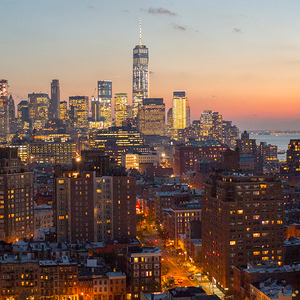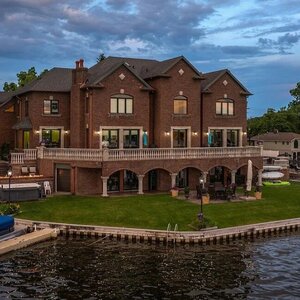The WPJ
THE WORLD PROPERTY JOURNALReal Estate Facts Not Fiction
Residential Real Estate News

U.S. Home Prices Reach New All-Time High in Q2
Residential News » Washington D.C. Edition | By Monsef Rachid | August 9, 2018 8:55 AM ET
Home Prices Rise 5.3 Percent Annually
According to the National Association of Realtors, amidst staggeringly low inventory levels in much of the country during the second quarter of 2018, existing-homes sales cooled and home prices maintained their robust level of appreciation. Last quarter, the San Francisco metro area joined the San Jose metro area for having a median sales price above $1 million.
The national median existing single-family home price in the second quarter was $269,000, which is up 5.3 percent from the second quarter of 2017 ($255,400) and surpasses last year's second quarter as the new peak. The median sales price during this year's first quarter increased 5.7 percent from the first quarter of 2017.
Single-family home prices last quarter increased in 90 percent of measured markets, with 161 out of 178 metropolitan statistical areas1 (MSAs) showing sales price gains in the second quarter compared to a year ago. Twenty-four metro areas (13 percent) experienced double-digit increases, down from 30 percent in this year's first quarter.
Lawrence Yun, NAR chief economist, says this year's spring buying season did not meet expectations, despite very strong demand. "The ongoing supply crunch affecting much of the country worsened for most of the second quarter, as the growing number of interested buyers in many markets overwhelmed what was already a meager level of available listings," he said. "With not enough homes for sale, multiple bids caused prices to rise briskly and further out of the reach of some prospective buyers."
Total existing-home sales, including single family and condos, decreased 1.7 percent to a seasonally adjusted annual rate of 5.41 million in the second quarter from 5.51 million in the first quarter, and are 2.4 percent lower than the 5.55 million pace during the second quarter of 2017.
"Solid economic growth, a healthy labor market and the large millennial population should be driving home sales much higher," said Yun. "As long as economic conditions maintain current levels, there's still a chance for sales to break out this year. However, with mortgage rates trending higher, it will only happen if supply levels improve enough to cool the speedy price growth in a majority of the country."
At the end of the second quarter, there were 1.95 million existing homes available for sale, which was 0.5 percent above the 1.94 million homes for sale at the end of the second quarter in 2017. The average supply during the second quarter was 4.1 months - down from 4.2 months in the second quarter of last year.
The national family median income rose to $75,106 in the second quarter, but overall affordability decreased from a year ago because of higher mortgage rates and home prices. To purchase a single-family home at the national median price, a buyer making a 5 percent down payment would need an income of $64,239, a 10 percent down payment would require an income of $60,858, and $54,096 would be needed for a 20 percent down payment.
"The unaffordable conditions in many of the largest metro areas - especially in the West - continues to be a growing concern for many middle-class households aspiring to buy a home," said Yun. "Homebuilders, facing higher costs and labor shortages, are simply not producing enough affordable homes to satisfy demand. Local governments need to acknowledge this glaring issue and ease some of the zoning laws, permitting processes and regulations that are slowing construction."
The five most expensive housing markets in the second quarter were the San Jose, California metro area, where the median existing single-family price was $1,405,000; San Francisco-Oakland-Hayward, California, $1,070,000; Anaheim-Santa Ana-Irvine, California, $830,000; urban Honolulu, $795,200; and San Diego-Carlsbad, $645,000.
The five lowest-cost metro areas in the second quarter were Youngstown-Warren-Boardman, Ohio, $94,400; Cumberland, Maryland, $94,900; Decatur, Illinois, $96,900; Elmira, New York, $106,300; and Erie, Pennsylvania, at $121,700.
Metro area condominium and cooperative prices - covering changes in 61 metro areas - showed the national median existing-condo price was $248,200 in the second quarter, up 3.6 percent from the second quarter of 2017 ($239,600). Ninety percent of metro areas showed gains in median condo price from a year ago.
Regional Breakdown
Total existing-home sales in the Northeast were at an annual rate of 683,000 (unchanged from a year ago) and down 8.9 percent from a year ago. The median existing single-family home price in the Northeast was $288,900 in the second quarter, up 2.3 percent from a year ago.
In the Midwest, existing-home sales rose 1.6 percent in the second quarter but are 2.8 percent below a year ago. The median existing single-family home price in the Midwest grew 3.5 percent to $210,600 in the second quarter from the same quarter a year ago.
Existing-home sales in the South declined 2.7 percent in the second quarter but are 0.6 percent higher than the second quarter of 2017. The median existing single-family home price in the South was $238,500 in the second quarter, 4.0 percent above a year earlier.
In the West, existing-home sales in the second quarter decreased 4.1 percent and are 3.6 percent below a year ago. The median existing single-family home price in the West increased 8.3 percent to $403,300 in the second quarter from the second quarter of 2017.
According to the National Association of Realtors, amidst staggeringly low inventory levels in much of the country during the second quarter of 2018, existing-homes sales cooled and home prices maintained their robust level of appreciation. Last quarter, the San Francisco metro area joined the San Jose metro area for having a median sales price above $1 million.
The national median existing single-family home price in the second quarter was $269,000, which is up 5.3 percent from the second quarter of 2017 ($255,400) and surpasses last year's second quarter as the new peak. The median sales price during this year's first quarter increased 5.7 percent from the first quarter of 2017.
Single-family home prices last quarter increased in 90 percent of measured markets, with 161 out of 178 metropolitan statistical areas1 (MSAs) showing sales price gains in the second quarter compared to a year ago. Twenty-four metro areas (13 percent) experienced double-digit increases, down from 30 percent in this year's first quarter.
Lawrence Yun, NAR chief economist, says this year's spring buying season did not meet expectations, despite very strong demand. "The ongoing supply crunch affecting much of the country worsened for most of the second quarter, as the growing number of interested buyers in many markets overwhelmed what was already a meager level of available listings," he said. "With not enough homes for sale, multiple bids caused prices to rise briskly and further out of the reach of some prospective buyers."
Total existing-home sales, including single family and condos, decreased 1.7 percent to a seasonally adjusted annual rate of 5.41 million in the second quarter from 5.51 million in the first quarter, and are 2.4 percent lower than the 5.55 million pace during the second quarter of 2017.
"Solid economic growth, a healthy labor market and the large millennial population should be driving home sales much higher," said Yun. "As long as economic conditions maintain current levels, there's still a chance for sales to break out this year. However, with mortgage rates trending higher, it will only happen if supply levels improve enough to cool the speedy price growth in a majority of the country."
At the end of the second quarter, there were 1.95 million existing homes available for sale, which was 0.5 percent above the 1.94 million homes for sale at the end of the second quarter in 2017. The average supply during the second quarter was 4.1 months - down from 4.2 months in the second quarter of last year.
The national family median income rose to $75,106 in the second quarter, but overall affordability decreased from a year ago because of higher mortgage rates and home prices. To purchase a single-family home at the national median price, a buyer making a 5 percent down payment would need an income of $64,239, a 10 percent down payment would require an income of $60,858, and $54,096 would be needed for a 20 percent down payment.
"The unaffordable conditions in many of the largest metro areas - especially in the West - continues to be a growing concern for many middle-class households aspiring to buy a home," said Yun. "Homebuilders, facing higher costs and labor shortages, are simply not producing enough affordable homes to satisfy demand. Local governments need to acknowledge this glaring issue and ease some of the zoning laws, permitting processes and regulations that are slowing construction."
The five most expensive housing markets in the second quarter were the San Jose, California metro area, where the median existing single-family price was $1,405,000; San Francisco-Oakland-Hayward, California, $1,070,000; Anaheim-Santa Ana-Irvine, California, $830,000; urban Honolulu, $795,200; and San Diego-Carlsbad, $645,000.
The five lowest-cost metro areas in the second quarter were Youngstown-Warren-Boardman, Ohio, $94,400; Cumberland, Maryland, $94,900; Decatur, Illinois, $96,900; Elmira, New York, $106,300; and Erie, Pennsylvania, at $121,700.
Metro area condominium and cooperative prices - covering changes in 61 metro areas - showed the national median existing-condo price was $248,200 in the second quarter, up 3.6 percent from the second quarter of 2017 ($239,600). Ninety percent of metro areas showed gains in median condo price from a year ago.
Regional Breakdown
Total existing-home sales in the Northeast were at an annual rate of 683,000 (unchanged from a year ago) and down 8.9 percent from a year ago. The median existing single-family home price in the Northeast was $288,900 in the second quarter, up 2.3 percent from a year ago.
In the Midwest, existing-home sales rose 1.6 percent in the second quarter but are 2.8 percent below a year ago. The median existing single-family home price in the Midwest grew 3.5 percent to $210,600 in the second quarter from the same quarter a year ago.
Existing-home sales in the South declined 2.7 percent in the second quarter but are 0.6 percent higher than the second quarter of 2017. The median existing single-family home price in the South was $238,500 in the second quarter, 4.0 percent above a year earlier.
In the West, existing-home sales in the second quarter decreased 4.1 percent and are 3.6 percent below a year ago. The median existing single-family home price in the West increased 8.3 percent to $403,300 in the second quarter from the second quarter of 2017.
Sign Up Free | The WPJ Weekly Newsletter
Relevant real estate news.
Actionable market intelligence.
Right to your inbox every week.
Real Estate Listings Showcase
Related News Stories
Residential Real Estate Headlines
- Zombie Foreclosures Edge Up Across U.S.
- 2.6 Million Homes at Wildfire Risk Across 14 Western States in 2025
- One in Five Americans Willing to Trade Personal Safety for Home Affordability
- U.S. Home Price Growth Slows as Affordability Pressures Mount in 2025
- U.S. Mortgage Rates Dip to Four Month Low in Early August
- U.S. Mortgage Applications Rise in Late July, Breaking Four-Week Slump
- Hong Kong's Housing Market Stuck in Stalemate as Bulls and Bears Face Off
- U.S. Condo Market Struggles in 2025
- U.S. Pending Home Sales Remain Sluggish in June
- Los Angeles Area Wildfires Destroyed Nearly $52 Billion in Homes Last January
- Greater Palm Beach Area Residential Sales Slip in June Amid Growing Inventory
- Economic Resilience Lifts U.S. Housing Outlook Going Forward
- New Home Sales Stagnate as Affordability Struggles Continue in America
- U.S. Housing Market Slips in June as Prices Hit New Highs
- Florida, California Continue to Reign Supreme as America's Ultraluxury Housing Markets
- Caribbean Housing Market Evolves into Global Second-Home Hotspot
- U.S. Home Sales See Highest June Cancellation Rate on Record
- Orlando Housing Market Cools in June as Listings Slide, Sales Slow
- Private Credit Surges in 2025 as Real Estate Developers Bypass Banks
- U.S. Condo Market Suffers Sharpest Price Drops in Over a Decade as Buyers Retreat
- Rising Taxes, Insurance Costs Undermine the Stability of U.S. Homeownership
- Foreign Investment in U.S. Homes Surges to $56 Billion, Highest Growth Since 2017
- Tariffs, Weak Canadian Dollar Cool U.S. Real Estate Demand from Canadians
- U.S. Remodeling Market Sentiment Slips in Q2
- Monaco F1 Grand Prix Sparks Local Property Frenzy
- Canada Home Sales Climb for First Time in 6 Months as Market Stabilizes
- U.S. Real Estate Associations Applaud Senate Passage of Trump's Big Beautiful Bill
- Greater Fort Lauderdale Area Residential Sales Dive 18 Percent Annually in May
- Top 10 Things to Know About the U.S. Housing Market Mid-2025
- Global Luxury Housing Rents Stabilize as Post-Covid Surge Cools
- World Property Ventures to Reorganize as a Digital Investment Bank
- FHFA Signals to Count Crypto in U.S. Mortgage Underwriting
- Greater Miami Area Residential Sales Implode 20 Percent Annually in May
- U.S. Home Sales Remain Sluggish in May
- Ireland Home Prices Surge 12.3 Percent Annually in Q2
- Global Super-Prime Housing Markets Rally in 2025
- Home Flipping in U.S. Hits Lowest Level Since 2018
- World Property Markets to Launch Industry Wide Joint Venture Funding Round
- Greater Orlando Home Sales Down 12 Percent Annually as Inventory Hits 14-Year High
- Sluggish Fed Rate Cuts in 2025 Keep U.S. Home Sales on Ice
Reader Poll
Marketplace Links
This website uses cookies to improve user experience. By using our website you consent in accordance with our Cookie Policy. Read More







